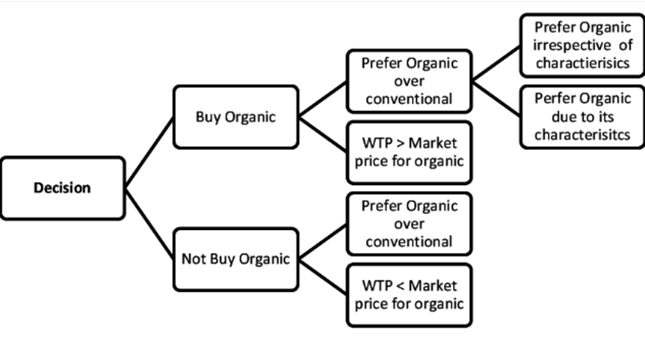It’s an art to understand your consumer’s needs and behavior as an FMCG marketer. The consumer decision tree is a useful tool to visualize the decision-making process. In this blog, we will share our vision of this well-known marketing model.
What’s the consumer decision tree?
A consumer decision tree is a visual representation of the consumer’s decision-making process in terms of FMCG products. If you’re googling around on this model, you will come across different versions of the consumer decision tree. Consequently, you can interpret and apply this model in many ways.
For example, you can use this model to represent your consumer’s thoughts in different stages of the decision-making process. You can fill in the consumer decision tree on aspects such as brand, product, category, design and price.
The example below zooms in on the motives of consumers to choose organic products or not (Source: Research Gate).

How to use the consumer decision tree?
The consumer decision tree is a useful tool to visualize the behavior and attitudes of consumers. With market research, you can get insights on topics about aspects of the decision-making process such as:
- Do people buy your product for direct consumption or in-home consumption?
- How does a consumer choose between private label and branded products?
- Which health claim is the most successful for meat substitutes?
How predictable is consumer behavior?
The consumer decision tree is a handy tool to represent the attitudes and behavior of consumers. In practice, it is still difficult to predict consumer behavior. After all, the failure rate of FMCG innovations is still 80%.
There are many factors involved in this issue. (By the way, we wrote an e-paper about that, which you can download for free.)
But if we zoom into this matter from a market research perspective, we can see that many studies are based on interviews with consumers or online panels. This is a highly debatable point since we question the respondents’ ability to empathize with how they would act in real life.
In addition, conversations with consumers provide insights into opinions and attitudes, but those conversations are only slightly predictable for their behavior. This matter is called the ‘say-do gap’, also known as the intention-behavior gap. For example, a consumer can mention in an interview that he will buy organic food but can make a different choice when standing in front of the supermarket shelf.
More information
Do you want to map the consumer decision tree for your product innovations? Do you want to make decisions based on consumer behavior? Please contact Chantal Risseeuw-Boer, our Client Development Consultant at chantal@bamboobrands.com / 06 41 290 172.






